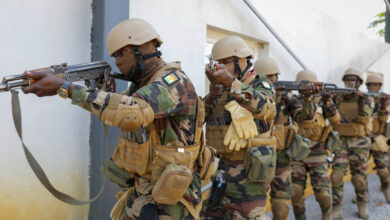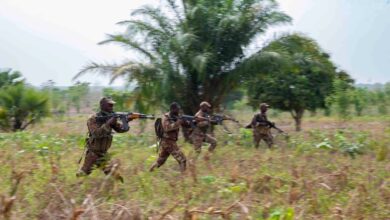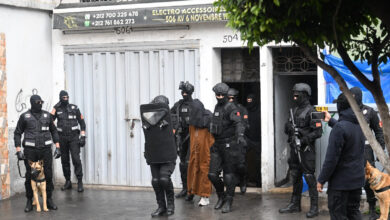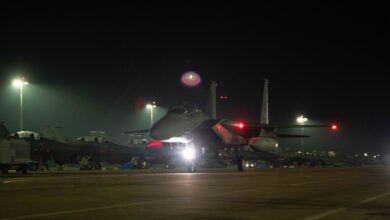A bomb and gun attack on the headquarters of the G5 Sahel Joint Force in the Mopti region of Mali on Friday, June 29 left at least five people dead.
#Mali: Attaque contre le QG du G5 Sahel à #Sevaré. Forte explosion
suivie de tirs à l’arme automatique. (Source Sécuritaire)
— Baba Ahmed (@Baba_A_) June 29, 2018
There were a number of reports of a large explosion followed by gunfire, which lasted for at least an hour.
“Shortly after Friday prayers, a suicide bomber in a vehicle painted with U.N. colours blew up at the entrance to the G5 base in Sevare. It was a huge blast,” a military source in the G5 Sahel force told AFP.
At least two soldiers were killed, G5 Sahel spokesperson Abdoul Salam Diagana told AP, adding that several others are injured and the toll “will evolve.”
Diagana said two attackers were also killed, and two more captured.
In a later statement, the government of Mali said that two Malian Armed Forces G5 Sahel personnel were killed in the “terrorist” attack, while three “on the enemy side” died, adding that the attack caused “significant material damage.”
A civilian was also killed, Sidi Alassane Toure, the governor of Mopti, told AFP
“We have arrested four suspects,” he said, adding that search operations would take all night.
Earlier, a hospital source said six people were killed, AFP reported.
“We transported the bodies and the injured to the hospital, but we don’t know whether some of the injured have died in hospital. There are six dead on the ground,” a military source told AFP.
Mali’s defense ministry said the base in Sevare was attacked with rockets.
“The attackers fired rockets at the headquarters and some of them infiltrated the compound. There was an exchange of fire,” defense ministry spokesman Boubacar Diallo told Reuters.
The ministry later said that a vehicle bomb was also used in the attack.
A Senagalese quick reaction force reportedly deployed to the base, and helicopters were heard in the area.
A suicide bomber tried to storm the base, AFP reported citing a security source. A witness, identified as Haoussa Haidara, said “there was a huge blast” followed by gunfire.
Other reports said that the source of the explosion was a suicide vehicle bomb.
#Mali: Aftermath of the attack against the #G5Sahel-Force HQ in Sevare, #Mopti, the crater and the damages confirms SVBIED pic.twitter.com/4PAA0L6Nrn
— MENASTREAM (@MENASTREAM) June 29, 2018
The attack was reportedly claimed by an official from the Support Group for Islam and Muslims (JNIM), al-Qaeda’s branch in Mali. The official said the attack began with a suicide car bomb followed by the storming of the camp.
In a similar attack in April, militants attacked French and UN bases in Timbuktu killing one U.N. peacekeeper and injuring dozens. Rockets were then fired by gunmen wearing blue helmets who had vehicles rigged with bombs, one of which had improvised U.N. markings.
#Mali: Another set of images from the #G5Sahel-Force HQ in Sevare, #Mopti, showing wreckage of SVBIED pic.twitter.com/NeSq0YDqmg
— MENASTREAM (@MENASTREAM) June 29, 2018
The attack comes just days after an investigation carried out by the U.N. mission in Mali concluded that Mali soldiers executed 12 civilians in Boulikessi in May.
It is also three days before a planned meeting of the heads of the G5 Sahel states with French President Emmanuel Macron to discuss progress made by the force.
The G5 Sahel, comprised of Burkina Faso, Chad, Mali, Mauritania and Niger, was launched in 2014 to improve cooperation on development and security in West Africa.
They launched the G5 Sahel joint counter-terrorism force in July 2017. Its mandate is to combat terrorism, transnational organized crime and human trafficking in the Sahel area.
The five nations aim to deploy 5,000 troops in the region along the southern edge of the Sahara desert to work alongside thousands of troops deployed to France’s Operation Barkhane in the wider Sahel and the U.N.’s Minusma peacekeeping mission in Mali.
Last month Niger’s defense minister said the force was ready to launch operations, but a push by France and U.N. Secretary-General Antonio Guterres for direct funding was rejected by the United States at the Security Council.
On June 13, the European Union’s diplomatic chief Federica Mogherini proposed a new €10.5 billion ($12.4 billion) European Peace Facility that could pay for military equipment for partners in crisis zones such as Africa’s Sahel region, including the G5 Sahel Joint Force.
This is a developing story and will be updated. It includes reporting from AFP.












